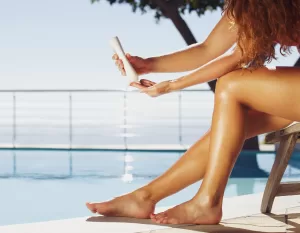Sun protection is essential to maintaining healthy skin and preventing skin damage and cancer. While the sun provides many benefits, too much exposure can be harmful. The sun’s ultraviolet (UV) rays from the sun can cause damage to our skin, leading to premature aging, sunburn, and even skin cancer.
This blog will discuss the importance of sun protection and provide five ways to protect your skin from harmful UV rays. Whether you enjoy spending time outdoors or want to keep your skin healthy, read on to learn more about the importance of sun protection.
The sun is essential for life on Earth. Without it, there would be no photosynthesis, and life as we know it would cease to exist. However, while the sun provides many benefits, too much sun exposure can also be harmful. The sun’s ultraviolet (UV) rays from the sun can cause damage to our skin, leading to premature aging, sunburn, and even skin cancer.
UV (ultraviolet) radiation is electromagnetic radiation emitted by the sun. UV radiation is a form of energy that travels in waves and has different wavelengths. There are three types of UV radiation: UVA, UVB, and UVC. Sun protection of Florida is crucial since the state is known for having intense summers.

UVC radiation has the shortest wavelength and is the most active type of UV radiation. However, it is mostly absorbed by the Earth’s atmosphere and does not reach the surface. UVA radiation has a longer wavelength and can penetrate deep into the skin, causing damage to the dermis layer. UVB radiation has a shorter wavelength than UVA and affects the outer layer of the skin, causing sunburn and other skin damage.
When UV radiation penetrates the skin, it can cause damage to the DNA in skin cells, leading to mutations and other cellular changes that can result in skin cancer. The body has natural defense mechanisms against UV radiation, such as melanin production and skin thickening, but these defenses can be overwhelmed with excessive exposure to UV radiation.
This article will discuss the importance of sun protection and provide 5 ways to protect your skin from harmful UV rays.
1. Wear Protective Clothing
One of the simplest ways to protect your skin from harmful UV rays is to wear protective clothing. Clothing can act as a barrier, preventing UV rays from penetrating your skin. Opt for tightly woven fabrics, such as denim or polyester, when choosing clothes to wear in the sun. Loose, lightweight fabrics like cotton are less effective at blocking UV rays. Also, choose clothing covering as much skin as possible, such as long-sleeved shirts, pants, and hats.
When choosing a hat for sun protection, look for one with a wide brim that shades your face, neck, and ears. A baseball cap may protect your face but won’t protect your ears or neck. Similarly, if you’re wearing a short-sleeved shirt, consider wearing a lightweight jacket or shawl to cover your arms and shoulders.
Hats are essential to protective clothing for the face, neck, and ears. When choosing a hat for sun protection, look for one with a wide brim that shades your face, neck, and ears. A baseball cap may protect your face but won’t protect your ears or neck. Similarly, if you’re wearing a short-sleeved shirt, consider wearing a lightweight jacket or shawl to cover your arms and shoulders. Arm sleeves for sun protection are a practical option for protecting your skin.
Another consideration when choosing protective clothing is color. Dark colors absorb more UV rays than lighter ones, so a dark-colored shirt may be more effective at blocking UV rays than a light-colored one. However, lighter colors can be more comfortable in hot weather, so balancing comfort and protection is important.
2. Use Sunscreen
Another important way to protect your skin and have sun protection from harmful UV rays is sunscreen. Sunscreen is a product that is applied to the skin and helps to absorb or reflect UV rays. When choosing a sunscreen, look for one with a sun protection factor (SPF) of at least 30. The higher the SPF, the more protection the sunscreen provides.
Also, choose a broad-spectrum sunscreen that protects against UVA and UVB rays. UVA rays are responsible for premature aging, while UVB rays cause sunburn. By using a broad-spectrum sunscreen, you can protect your skin from both types of UV rays.
It’s also important to apply sunscreen correctly. Apply a generous amount of sunscreen to all exposed skin for at least 15 minutes before going outside. Reapply the sunscreen every two hours or more often if you’re swimming or sweating.

Sunscreens are a type of sun protection that absorb or reflect UV radiation before it penetrates the skin. Chemical sunscreens contain organic compounds that absorb UV radiation, while physical sunscreens contain inorganic compounds that reflect and scatter UV radiation away from the skin.
Chemical sunscreens are generally lightweight and easier to apply than physical sunscreens, but they may provide less protection for sensitive skin or those with allergies. Chemical sunscreens create a chemical reaction that absorbs UV radiation and converts it into heat energy, which is then released from the skin. These sunscreens typically contain ingredients such as avobenzone, octinoxate, and oxybenzone.
On the other hand, physical sunscreens are a type of sun protection that contain inorganic compounds such as zinc oxide or titanium dioxide. These compounds reflect and scatter UV radiation away from the skin, providing a physical barrier that blocks the sun’s rays. Physical sunscreens are often preferred for people with sensitive skin or allergies because they are less likely to cause skin irritation. However, they can be thicker and more difficult to apply than chemical sunscreens.
Sunscreens with an SPF (sun protection factor) of 30 or higher are recommended for daily use, but people with fair skin or who spend a lot of time outdoors may benefit from a higher SPF. When choosing a sunscreen, it’s important to look for one that is broad-spectrum, which means it protects against UVA and UVB radiation. It’s also important to apply sunscreen correctly and reapply it every two hours or after swimming or sweating for optimum sun protection.
3. Seek Shade
When spending time outdoors, seek shade whenever possible. This is especially important when the sun’s rays are strongest, typically between 10 a.m. and 4 p.m. If you’re at the beach or in a park, look for a shady spot under a tree or bring an umbrella to create shade.
It’s important to note that shade alone cannot protect your skin from UV rays. UV rays can still penetrate through trees and umbrellas, so wear protective clothing and sunscreen even in the shade.
When seeking shade, being mindful of your surroundings is also important. For example, if you’re sitting under a tree, be aware that the sun’s rays can still reach your skin through gaps in the leaves. Similarly, if you’re sitting under an umbrella, be aware that the sun’s rays can reflect off nearby surfaces, such as water or sand, and reach your skin from below.
In addition to seeking shade, it’s important to take other precautions when spending time outdoors, such as wearing protective clothing, sunscreen, and sunglasses to protect your eyes. By taking a comprehensive approach to sun protection, you can reduce your risk of skin damage and maintain healthy skin.
4. Wear Sunglasses
In addition to protecting your skin, it’s also important to protect your eyes from UV rays. UV rays can cause damage to the eyes, leading to cataracts, macular degeneration, and other eye problems. To protect your eyes from UV rays, wear sunglasses that block 100% of both UVA and UVB rays.
When choosing sunglasses, look for ones that fit snugly and cover your eyes and the surrounding areas. Wraparound sunglasses are an excellent choice because they provide additional protection from the sides. Additionally, choose sunglasses that have a lens tint of gray or brown. These tints are the most effective at reducing glare and allowing you to see colors accurately.
5. Be Mindful of Reflections
Finally, be mindful of reflections when spending time in the sun. UV rays can reflect off surfaces such as water, sand, and snow, increasing exposure to harmful UV rays. This means that even if you’re in the shade or wearing protective clothing, you can still be exposed to UV rays if you’re near reflective surfaces.
When spending time near sand or snow, wear sunglasses, a hat, and protective clothing to reduce exposure to UV rays. Wear polarized sunglasses to reduce glare and protect your eyes if you spend time near water. Additionally, consider wearing a rash guard or other protective clothing for water activities.
Conclusion
Protecting your skin from harmful UV rays is essential for maintaining healthy skin and preventing skin damage and cancer. By wearing protective clothing, using sunscreen, seeking shade, wearing sunglasses, and being mindful of reflections, you can reduce exposure to UV rays and protect your skin.
Remember to check your skin regularly for any changes or abnormalities, and consult a dermatologist if you notice anything concerning. With proper sun protection and skin care, you can enjoy spending time outdoors while keeping your skin healthy and safe.
Agape Family Health is dedicated to eliminating health inequalities and ensuring everyone can access high-quality medical care in Jacksonville, Florida. Agape Family Health is working to lessen health inequities and enhance the health and well-being of all residents in the Jacksonville area by adopting a holistic and cooperative approach. Stay in touch with us!



